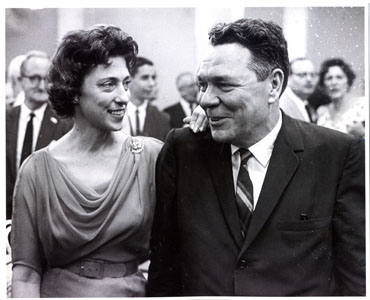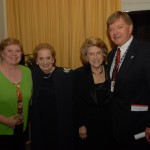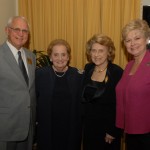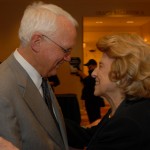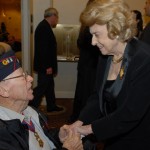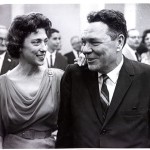Marie Corinne Morrison Claiborne “Lindy” Boggs (March 13, 1916 – July 27, 2013)
The passing of former US Representative Lindy Boggs on Saturday represents a great loss to The National WWII Museum and its large community of supporters. A gracious and determined figure who did much to bring minorities and women into the political mainstream in America, Boggs was heavily influenced by the World War II experience and played a key role in advancing the Museum’s development and mission.
Lindy Boggs served on the Museum’s Board of Trustees from 2002 to 2007, following service as US Ambassador to the Vatican. Her board tenure coincided with a period of intensive planning and growth for the New Orleans cultural institution. In 2003, Congress designated what was then known as The National D-Day Museum as America’s National WWII Museum, setting into motion a broad expansion of the Museum’s scope to cover all aspects of the war.
Boggs, who served nearly 18 years in Congress beginning in 1973, worked closely with US Rep. Bob Livingston, another Louisiana representative, in securing a $4 million federal appropriation essential to early planning for The National D-Day Museum, which opened in 2000. She also highlighted the WWII contributions of the WASP, or the Women Airforce Service Pilots, who received belated national recognition with the Congressional Gold Medal in 2009.
“She was a longtime champion for us, helped us with our advocacy through the years, and provided dedicated service on the Museum’s board. Even after she left Congress, her influence was still very strong,” said Museum President and CEO Gordon H. “Nick” Mueller. “Also, she was a member of the Greatest Generation, so she related very much to the significance of World War II in that period of history, and to our national history. She was very sensitive to the importance of the Museum’s mission.”
Before her move from New Orleans to Chevy Chase, Maryland following Hurricane Katrina, Boggs agreed to provide the introduction for former Secretary of State Madeleine Albright at the Museum’s International Conference on World War II in November 2006. While she faced health difficulties at the time, Boggs gave a flawless performance and was warmly greeted, recalls William Detweiler, the Museum’s military affairs consultant and a longtime Boggs friend.
“She had not made many public appearances since Hurricane Katrina and everyone that knew her wanted to speak to her and hear that greeting, ‘Darling, so good to see you.’ The love and respect was very evident,” Detweiler said.
Lindy Boggs won a special election to take over the Congressional seat of her husband, Hale Boggs, his plane disappeared in Alaska in 1972. Hale Boggs had served in the Navy during World War II and became a Democratic Party star in the postwar period, holding the post of House majority leader at the time of his disappearance.
As repercussions from World War II were deeply felt in American society, Lindy Boggs became a more forceful advocate for civic causes, joining a campaign by the Independent Women’s Organization in New Orleans to root out political corruption. As a close advisor to her husband and, later, as a member of Congress, she emerged as leading voice for minorities, women and the poor, assuming a mantle of leadership clearly influenced by the war era, according to Mueller.
The Museum president visited Mrs. Boggs at her home in the Washington DC area in May 2012 to pay respects to the longtime friend and update her on the Museum’s progress.
As news of Boggs’ death circulated on Saturday, Museum supporters paid tribute to her in Facebook messages. “Thank you for helping build a place where generations can learn what cost it took to preserve freedom not only for the United States, but for the whole world!” one message said. “Rest in Peace, Ma’am.”
- Maureen Detweiler, Madeleine Albright, Lindy Boggs and Bill Detweiler at the 2006 International Conference on WWII
- Nick Mueller, Madeleine Albright, Lindy Boggs and Beth Mueller at the 2006 International Conference on WWII
- Nick Mueller and Lindy Boggs at the 2006 International Conference on WWII
- Lindy Boggs greets a veteran at the 2006 International Conference on WWII.
- Lindy and Hale Boggs, circa 1962


